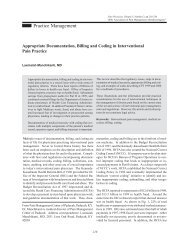ASIPP Practice Guidelines - Pain Physician
ASIPP Practice Guidelines - Pain Physician
ASIPP Practice Guidelines - Pain Physician
Create successful ePaper yourself
Turn your PDF publications into a flip-book with our unique Google optimized e-Paper software.
Manchikanti et al • <strong>ASIPP</strong> <strong>Practice</strong> <strong>Guidelines</strong><br />
65<br />
Even though there is a substantial amount of anecdotal<br />
evidence, there is no controlled prevalence data on the<br />
prevalence of myofascial pain. The authors exploring the<br />
role of trigger points and myofascial pain and whiplash<br />
injuries believe that the theory of trigger points lacks demonstrated<br />
internal validity. Formal studies also have shown<br />
that myofascial experts have difficulty in agreeing as to<br />
the presence of a trigger point, which is the cardinal feature<br />
of regional myofascial pain syndrome. In addition to<br />
this, it has been shown that topographically, trigger points<br />
of the neck overlay the cervical facet joints, and it has been<br />
reported that pain patterns of cervical trigger points are<br />
identical to those of referred pain from the facet joints.<br />
The same theories can be extrapolated to the lumbar spine.<br />
The literature describing effectiveness of trigger point injections<br />
is enormous. There were seven controlled studies<br />
(203-209) along with numerous observational studies.<br />
Collee et al (205), in a double-blind, randomized evaluation<br />
of local injection therapy of iliac crest pain syndrome<br />
and low back pain, studied the effectiveness of a single<br />
local injection of 5 mL of lignocaine, 0.5%, with 5 mL<br />
isotonic saline in 41 patients. The results showed that in<br />
the local anesthetic group, 52% of the patients improved<br />
and in the saline group, only 30% improved. The data<br />
demonstrated an effect of the local injection with lignocaine<br />
that is somewhat larger than an injection with saline, which<br />
also has some beneficial effect. The difference was not<br />
consistent across all the settings (rheumatology practice<br />
vs general practice).<br />
Bourne (206) compared corticosteroid - lignocaine injections<br />
with lignocaine alone in a trial of 57 patients suffering<br />
from chronic back pain. The results showed that corticosteroid<br />
- lignocaine mixture gave excellent results in 80%<br />
of 30 patients treated with the mixture and in only 16% of<br />
19 patients treated with lignocaine alone.<br />
Hamerhoff et al (207) compared bupivacaine, etidocaine,<br />
and saline for trigger point therapy in a randomized doubleblind<br />
crossover study. They reported increased relief with<br />
local anesthetic as compared with normal saline.<br />
Fine et al (208) evaluated the effects of myofascial trigger<br />
point injections, they reported pain relief in all subjects<br />
with the injection of 0.25% bupivacaine injection along<br />
with improvement in range of motion in those subjects who<br />
initially demonstrated the limitation of movement. They<br />
also showed that the relief achieved with trigger point injections<br />
was reversed with naloxone but not placebo.<br />
Jaeger and Shootsky (209) in a double-blind study evaluated<br />
the effect of dry-needling, saline, procaine, and placebo.<br />
They concluded that the use of saline or local anesthetic<br />
appears to be more effective than dry-needling or<br />
placebo.<br />
In a controlled double-blind evaluation of the comparison<br />
of mepivacaine injection versus saline injection for<br />
myofascial pain. Frost et al (203) studied 28 patients with<br />
acute, localized muscle pain by injecting four local injections<br />
of mepivacaine, 0.5%, in 28 patients, and local injection<br />
of an equal volume of normal saline in 25 patients.<br />
The group receiving saline tended to have more relief of<br />
pain, especially after the first injection. The results show<br />
that pain relief is not due merely to the local anesthetic.<br />
The study raises questions about the mechanism by which<br />
local injections into muscle relieve pain, since there is the<br />
possibility that a similar effect might also be achieved by<br />
merely inserting a needle into the trigger point. Normal<br />
saline is considered to be a more appropriate fluid for injection<br />
therapy than local anesthetic since it is less likely<br />
to produce side-effects. The positive aspects of this study<br />
include its inclusion of neck, shoulder, lumbar, and gluteal<br />
myofascial pain syndromes. The negative aspects include<br />
that normal saline was more effective than local anesthetic<br />
injection.<br />
Garvey et al (204), in a prospective, randomized, doubleblind<br />
evaluation of trigger point injection therapy for low<br />
back pain, evaluated 63 individuals with low back strain.<br />
Patients with nonradiating low back pain, with normal<br />
neurological examination, without sciatic tension signs, and<br />
with negative radiological evaluation and patients who<br />
failed two months of conservative treatment were included.<br />
Injection therapy was of four different types: lidocaine,<br />
lidocaine combined with a steroid, acupuncture, and vapocoolant<br />
spray with acupressure. The results showed that<br />
noninjection therapy was effective in 63% of the patients<br />
whereas injection therapy was effective in only 42% of the<br />
patients. Thus, this study showed that trigger point therapy<br />
seems to be useful in the treatment of low back strain, but<br />
the injection substance apparently is not the critical factor,<br />
since direct mechanical stimulus to the trigger point seems<br />
to give symptomatic relief equal to that of treatment with<br />
various types of injected medication.<br />
In terms of the quality of evidence presented with trigger<br />
point injection, the results were positive in five of the seven<br />
controlled studies (205, 209). Based on the above, type<br />
and strength of efficacy evidence is level III to level IV -<br />
moderate to limited. Level III – moderate is defined as<br />
<strong>Pain</strong> <strong>Physician</strong> Vol. 4, No. 1, 2001
















